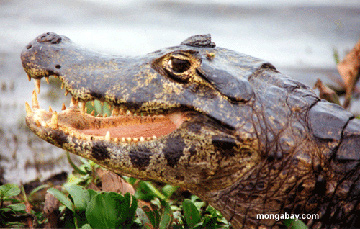Despite crocs in the Arctic, glaciers existed during extreme warming 90M years ago
Despite Arctic crocodiles, glaciers existed during extreme global warming 90M years ago
mongabay.com
January 10, 2008
|
|
Massive glaciers extended across 50-60 percent of Antarctica some 91.2 million years even as crocodiles roamed the Arctic and surface temperatures of the western tropical Atlantic Ocean climbed to 37 degrees Celsius (98 degrees Fahrenheit), reports a study published in the journal Science
Examining fossil records of microscopic marine organisms found in sea floor sediments off Suriname in South America, Andre Bornemann and colleagues were reconstructed an ancient sea temperature record, both at the surface and at depth. The international team then identified “temperature and chemical changes in the ocean that are consistent with periods of glacial formation,” according to a statement from Newcastle University.

|
“Our research from tropical marine sediments provides strong evidence that large ice sheets indeed did exist for short periods of the Cretaceous, despite the fact that the world was a much hotter place than it is today, or is likely to be in the near future,” said Newcastle University Geosciences Professor Thomas Wagner, a co-author of the study.
“The results are consistent with independent evidence from Russia and the USA that sea level fell by about 25-40 metres at this time,” added Jaap S. Damste, a professor at the Royal Netherlands Institute for Sea Research. “Sea level is known to fall as water is removed from the oceans to build continental ice-sheets and to rise as ice melts and returns to the sea. Today, the Antarctic ice cap stores enough water to raise sea level by about 60 metres if the whole mass melted and flowed back into the ocean.”
“This study demonstrates that even the super-warm climates of the Cretaceous Thermal Maximum were not warm enough to always prevent ice growth,” explained lead author Andre Bornmann of the Scripps Institute of Oceanography. “Certainly, ice sheets were much less common during the Cretaceous Thermal Maximum than they are during more recent ‘Icehouse’ climates, allowing tropical plants and animals like breadfruit trees and alligators to frequent the high arctic. However, paradoxically past greenhouse climates may actually have aided ice growth by increasing the amount of moisture in the atmosphere and creating more winter snowfall at high elevations and high latitudes.”
Bornemann, A. et al (2008). Isotopic Evidence for Glaciation During the Cretaceous Supergreenhouse,” Science 11 January 2008